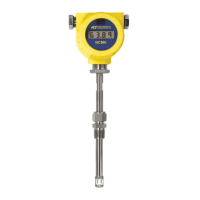
Do you have a question about the FCI ST50 and is the answer not in the manual?
| Type | Thermal Mass Flow Meter |
|---|---|
| Manufacturer | FCI |
| Media | Gas |
| Accuracy | ±1% reading, ±0.5% full scale |
| Repeatability | ±0.5% reading |
| Temperature Range | -40°C to +85°C (-40°F to +185°F) |
| Enclosure | NEMA 4X (IP66) |
| Approvals | ATEX, IECEx |
| Insertion Length | Customizable |
| Operating Temperature | -40°C to +85°C (-40°F to +185°F) |
| Storage Temperature | -40°C to +85°C (-40°F to +185°F) |
| Weight | Varies with configuration |
| Dimensions | Varies with configuration |
Ensure sensor elements align with flow direction for accurate calibration.
FCI recommends 20 pipe diameters upstream and 10 downstream for optimal performance.
Details on media compatibility, range, accuracy, compensation, approvals, and warranty.
Covers installation, material, pressure/temperature limits, and process connections.
Enclosure, output signals, input power, communication, and operating temperature.
Guidance on mounting the flow element using compression fittings with Teflon or metal ferrules.
Diagram and notes for precise element positioning relative to pipe centerline.
Formula and diagram for calculating the correct insertion depth for the flow element.
Steps to loosen fittings and retract the flow element safely from the process.
Essential precautions for handling the instrument to prevent electrostatic discharge damage.
Details on VDC and VAC input power configurations and wiring requirements.
Diagram for VDC power input and analog/pulse output connections.
Diagram for VAC power input and analog/pulse output connections.
Configuration options for pulse output, including modes, factor, and sample time.
Explanation of alarm, counter, and flow rate functions for pulse outputs.
Diagram illustrating the wiring for a source mode pulse output.
Diagram illustrating the wiring for a sink mode pulse output.
Settings for connecting and configuring the instrument via RS232.
Common commands used with the FC88 communicator for startup and commissioning.
Procedure for setting flow units and pipe dimensions using the 'Z' menu.
Overview of diagnostic and factory setting menus (C, D, K, R).
Configuration of flow units, pipe size, and scaling parameters.
Setup options for analog outputs and pulse output configurations.
Detailed steps for configuring 4-20mA outputs and NAMUR modes.
Steps for setting up pulse output source, sink, factor, and sample period.
Setting sample period, source state, and sink state for pulse outputs.
Guidelines for calibration, inspecting connections, wiring, and seals.
Periodic removal and inspection of the flow element for debris and damage.
Reviewing application parameters to ensure calibration matches process media.
Verifying installation and comparing process conditions with standard values.
Using the 'D' menu to examine parameters against the Delta R data sheet.
Verifying fuse continuity and seating of interconnecting cables.
Checking resistance of sensor element wires for continuity and correct values.
Steps for verifying transmitter calibration using resistance decade boxes and DVM.
EU Declarations for EMC, LVD, PED, and RoHS directives.
Reference for single-letter commands used for instrument configuration.
Reference for Command Line Interface (CLI) commands.
Continuation of the CLI commands list with descriptions and data types.
Illustrates how to use Read and Write functions within the CLI.
Diagrams showing various horizontal mounting orientations for integral transmitters.
Diagrams showing various vertical mounting orientations for integral transmitters.
Drawing details for the local probe configuration, including dimensions and fittings.
Drawing details for the remote enclosure configuration, including dimensions and connections.
Diagram for AC input power and analog/pulse output connections for integral units.
Diagram for DC input power and analog/pulse output connections for integral units.
Wiring diagram for remote electronics with AC power input.
Wiring diagram for remote electronics with DC power input.
Details on how to contact FCI for technical support via mail, phone, fax, and email.
Policy for handling warranty repairs and returns, including shipping responsibilities.
Information on requesting field service and associated billing rates.
Fields for customer contact, product details, and failure symptoms.
Options for return reason and payment methods for repairs.
Guidelines for safely packing instruments for return shipment.
Requirement for certifying that the instrument has been cleaned of hazardous materials.
Details on warranty coverage, exclusions, and buyer responsibilities.
